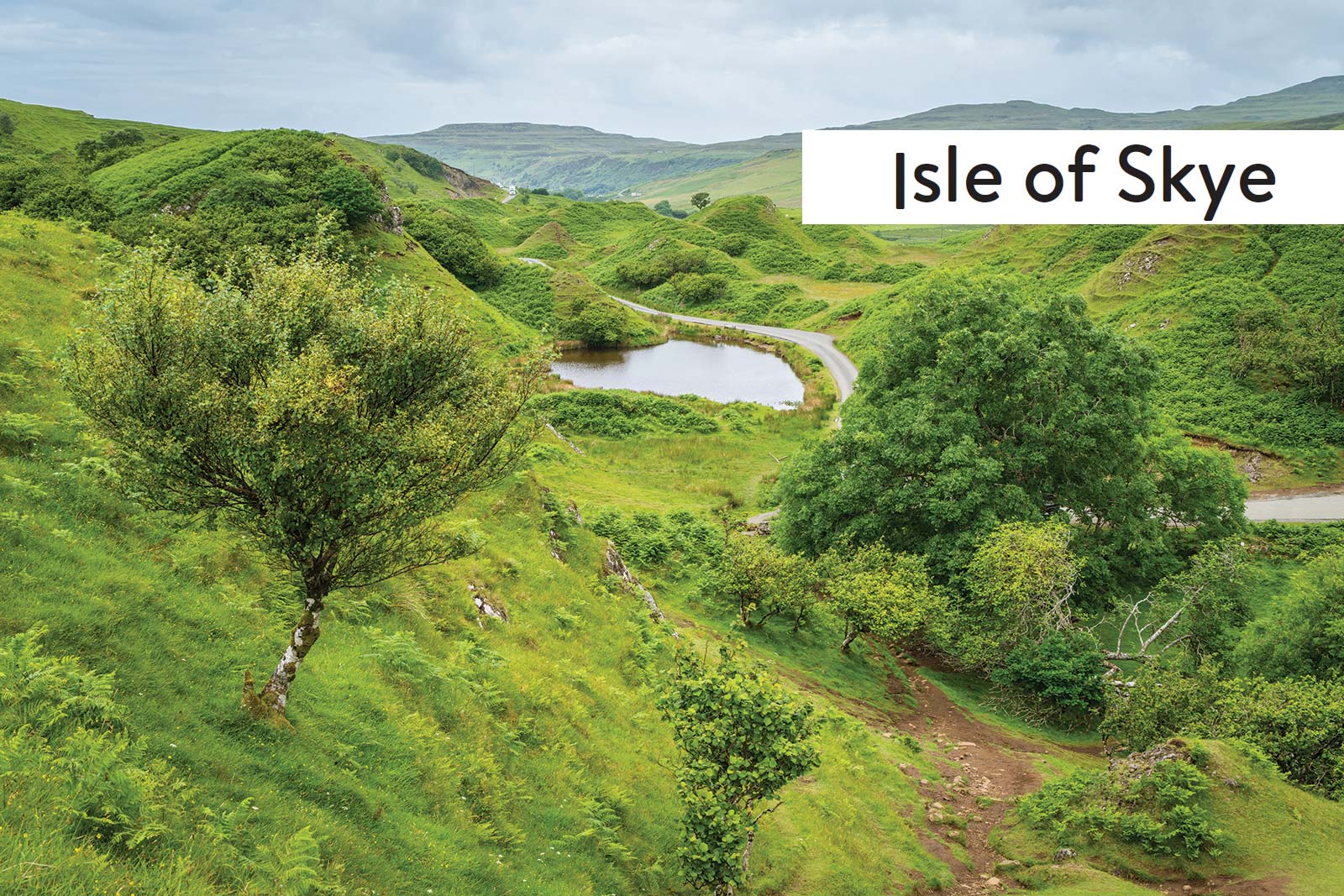
Getting Around the Isle of Skye
The rugged, remote-feeling Isle of Skye has a reputation for unpredictable weather, but it also offers some of Scotland’s best scenery. Narrow, twisty roads wind around Skye in the shadows of craggy, black, bald mountains, and the coastline is ruffled with peninsulas and sea lochs (inlets).
Skye is the Inner Hebrides’ largest island (over 600 square miles), but it’s still manageable: You’re never more than five miles from the sea. The island has only about 13,000 residents; roughly a quarter live in the main village, Portree. The mountain-like Cuillin Hills separate the northern part of the island (Portree, Trotternish, Dunvegan) from the south (Skye Bridge, Kyleakin, Sleat Peninsula).
Set up camp in Portree, Skye’s charming, low-key tourism hub. Then dive into Skye’s attractions. Drive around the appealing Trotternish Peninsula, enjoying scenic beauty: rolling fields, stony homes, and stark vistas of jagged rock formations. Go for a hike in the dramatic Cuillin Hills, sample a peaty dram of whisky, and walk across a desolate bluff to a lighthouse at the end of the world. Visit your choice of clan castles. Or just settle in, slow down, and enjoy island life.
Day 1: Starting from your home base at Portree, drive around the Trotternish Peninsula (could hike to the Old Man of Storr, visit the Skye Museum of Island Life, stop by Duntulm Castle ruins, and more). Hikers may want to get advice from Portree’s TI on longer hikes.
Day 2: Tour Dunvegan Castle, take the distillery tour, and hike to the Fairy Pools.
Skye is best explored by car (rentable in Portree), though minibus tours do cover the island’s major sights (as do public buses, but slowly and less efficiently).
Whether you like to hike or just don’t want to rush a good thing, the island is easily worth two days. But if you have only one day, visit the three big sights—Dunvegan Castle, Talisker Distillery, and the Trotternish Peninsula, with its memorable Skye Museum of Island Life.
If you’ll be taking the Skye Bridge to or from the island, be sure to get the picture-postcard view of Eilean Donan Castle on the mainland.
For details on arriving on Skye by ferry (from Mallaig on the mainland) and departing by bridge, see the end of this chapter.
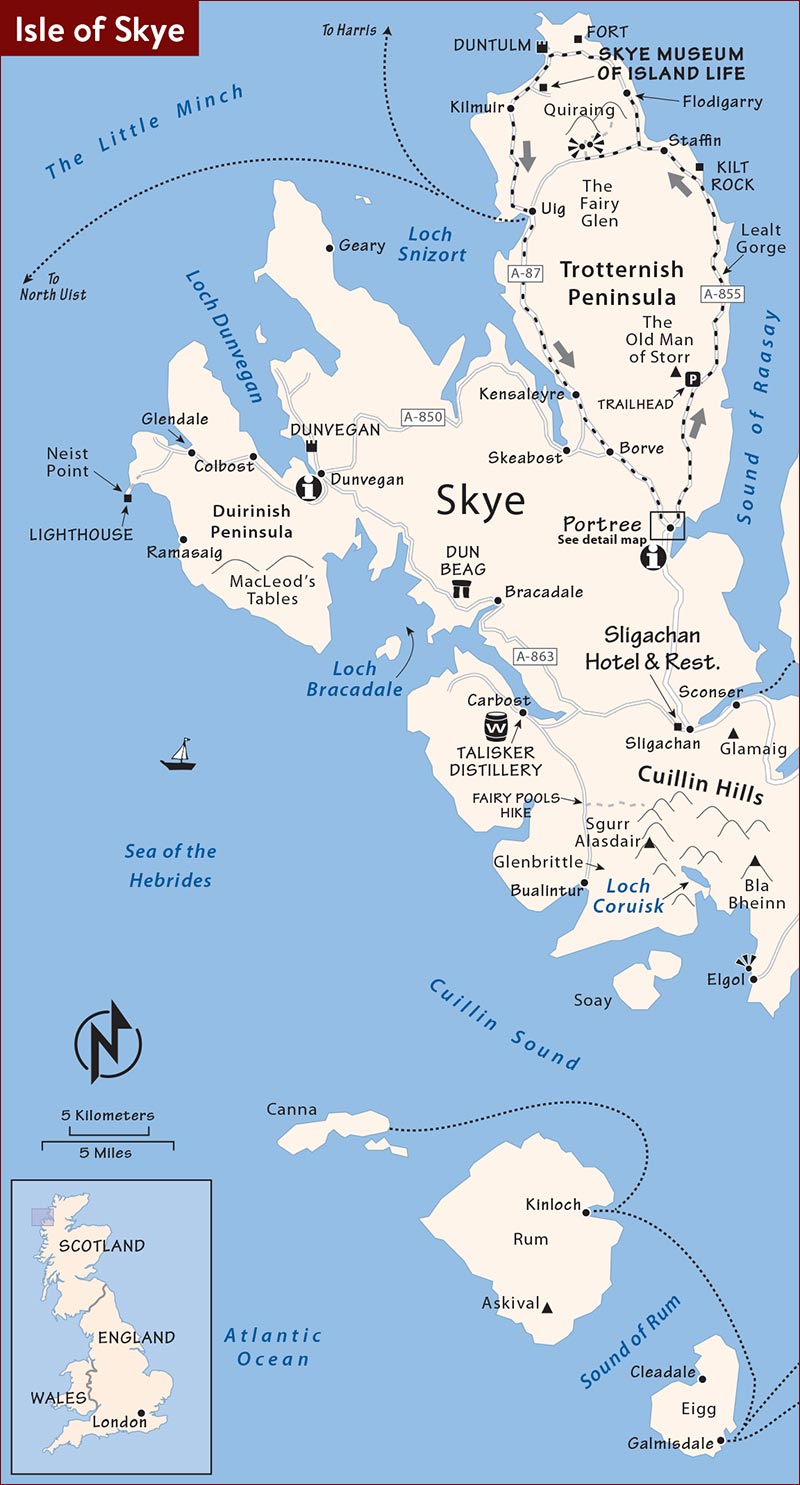
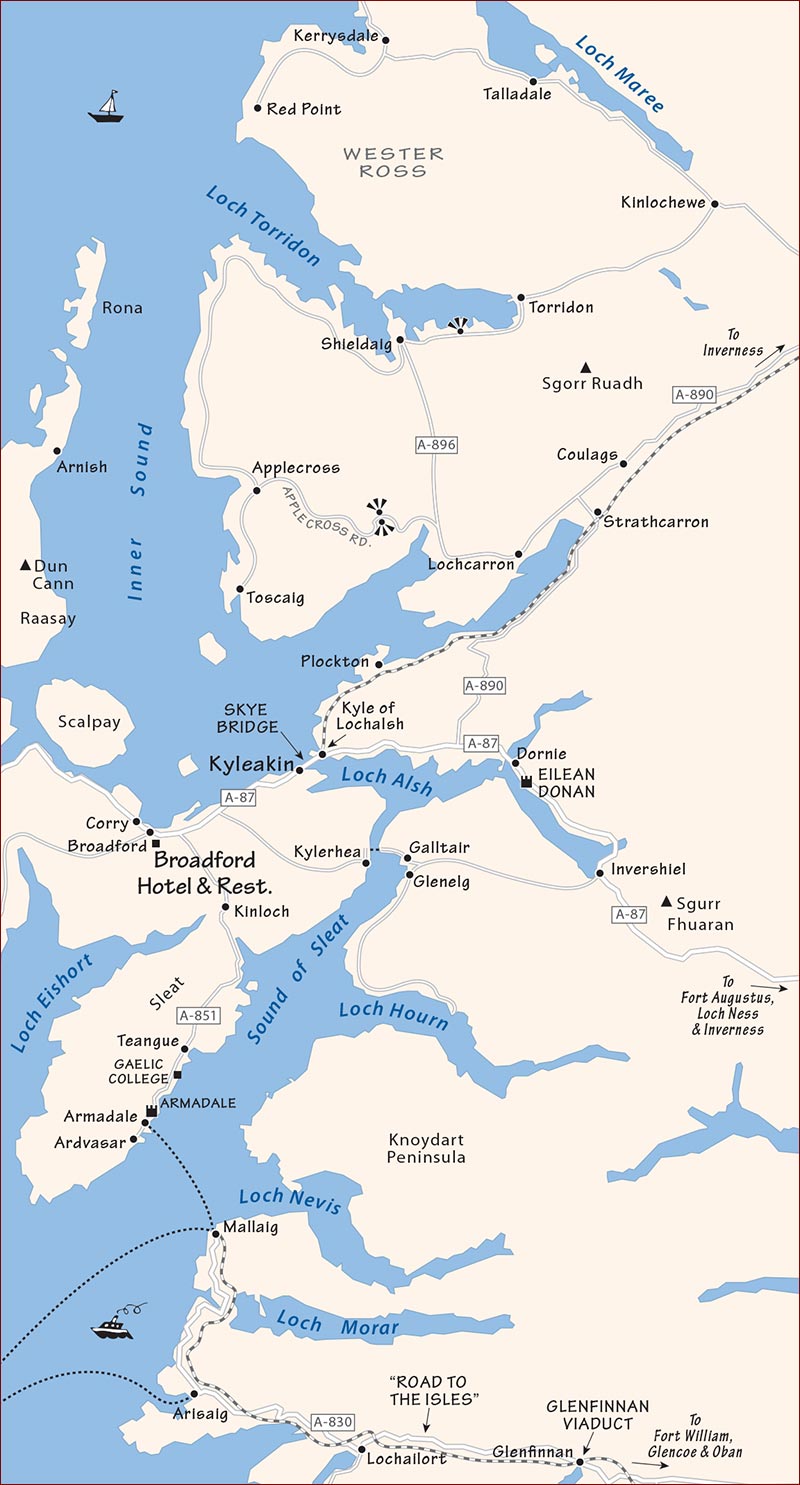
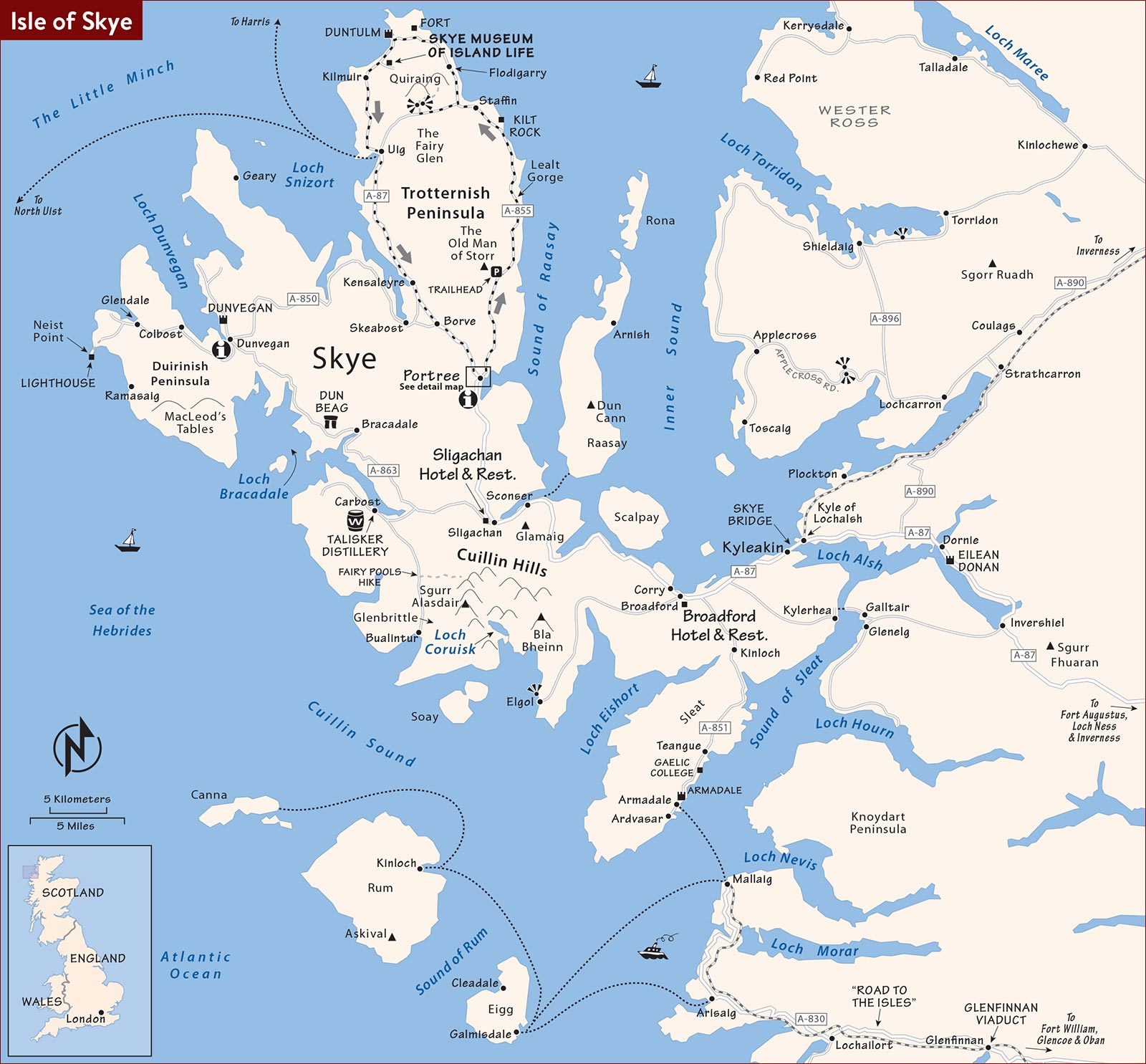
Skye’s main attraction is its natural beauty, not its villages. But of those villages, the best home base is Portree (pore-TREE), Skye’s largest settlement, transportation hub, and tourism center—ideally located for exploring Skye’s quintessential sights on the Trotternish Peninsula loop drive.
Portree is nestled deep in its protective, pastel harbor; overlapping peninsulas just offshore guard it from battering west coast storms. Most of today’s Portree dates from its early-19th-century boom time as a kelp-gathering and herring-fishing center.
As the most popular town on Scotland’s most popular island, Portree is jammed with visitors in the summer. There are lots of hotels and B&Bs (which book up well in advance) and an abundance of good restaurants (the best of which merit reservations).
Although Portree doesn’t have any real sights, it does boast a gorgeous harbor area and—in the streets above—all of the necessary tourist services: a good TI, fine B&Bs, great restaurants, a grocery store, a launderette, and so on. The main business zone of this functional town of about 3,000 residents is in the tight grid of lanes on the bluff just above the harbor, anchored by Portree’s tidy main square, Somerled Square. From here, buses fan out across the island and to the mainland. B&Bs line the roads leading out of town.

Portree
Tourist Information: Portree’s helpful TI is a block off the main square (June-Aug Mon-Sat 9:00-18:30, Sun until 17:00; off-season Mon-Sat 9:30-16:30, closed Sun; free Wi-Fi, just below Bridge Road, tel. 01478/612-137, www.visitscotland.com).
This is the island’s most useful TI, though shops in smaller towns (including Dunvegan) host basic “information points.”
WCs: Public WCs are across the street and down a block from the TI, across from the hostel.
Laundry: A self-service launderette is below the Independent Hostel, just off the main square (usually 11:00-21:00, last load starts at 20:00, The Green, tel. 01478/613-737).
Bike Rental: Island Cycles rents bikes in the middle of town, just off the main square (£10/half-day, £20/24 hours, best to reserve in advance in high season, Mon-Sat 9:00-17:00, closed Sun, shorter hours in winter, The Green, tel. 01478/613-121, www.islandcycles-skye.co.uk).
Car Rental: To make the most of your time on Skye, rent a car. Several options line up along the road to Dunvegan and charge around £40-60/day (most are closed Sun; smart to call several days ahead in peak season, but worth trying last-minute). The most user-friendly option is M2 Motors, which can pick you up at your B&B or the bus station (tel. 01478/613-344, www.m2-motors.co.uk). If they’re booked up, try Jansvans (tel. 01478/612-087, www.jans.co.uk), Highland Motors/HM Hire (based nearby in Borve but can pick up in Portree, tel. 01470/532-264, www.hm-hire.co.uk), or Morrison (tel. 01478/612-688, www.morrisoncarrental.com).
Parking: As you enter town, you’ll see signs on the right directing you to a free parking lot below, at water level—after parking, just head up the stairs to the TI. You can also pay-and-display to park in the main town square (2-hour max, free after 18:00).
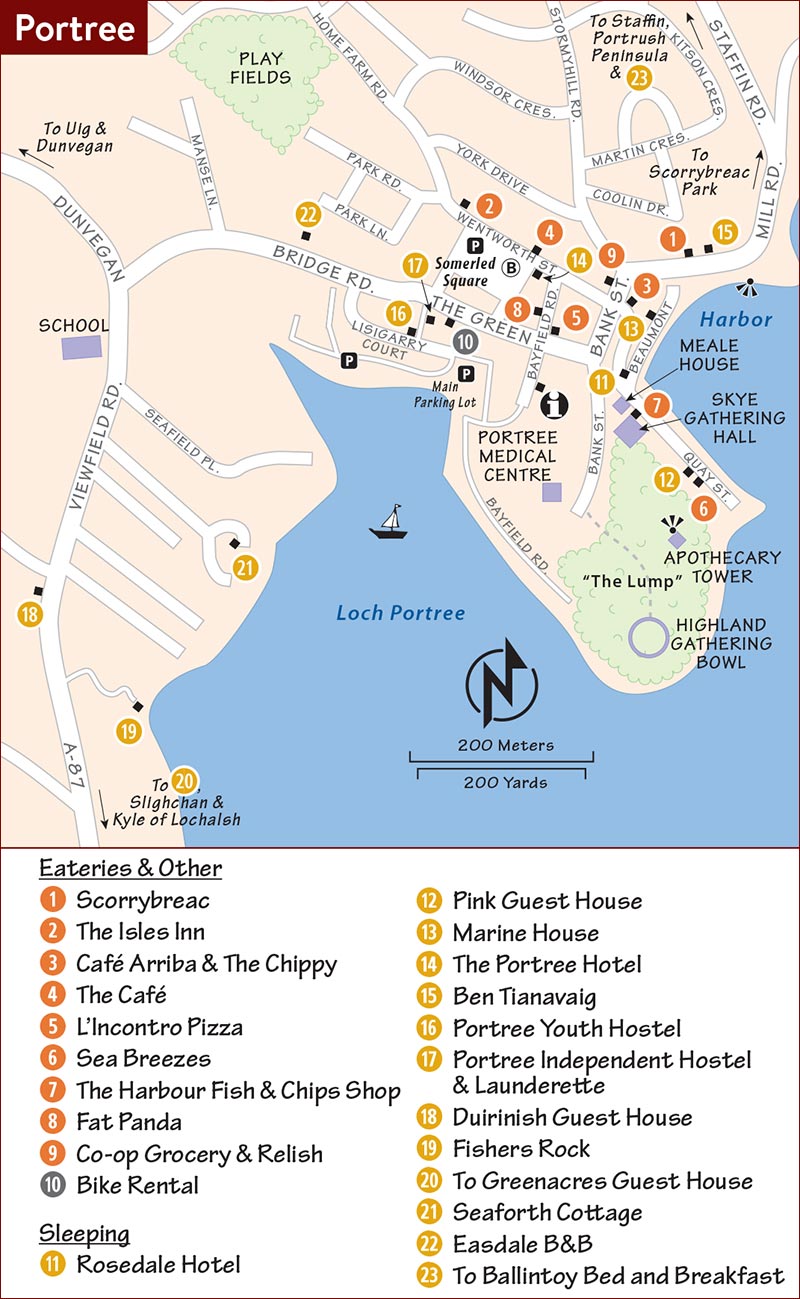
Town Walk: Michelle Rhodes leads guided one-hour town walks through Portree by request. While there’s not a lot to say about the town, it’s fun to have a local to explain things, and Michelle is a fine storyteller (£10 per person, call or email to set a time; mobile 07833-073-951, tel. 01478/611-915, www.skyehistoryandheritagetours.co.uk, michellelorrainerhodes@gmail.com). She also offers all-day guided driving tours around the island, tailored to your interests. Her specialty: clan battles, fairies, myths, and legends (£150 for two, £75/extra person).
SOMERLED SQUARE AND THE TOWN CENTER
There’s not a turnstile in town, but Portree itself is fun to explore. Below I’ve described the village’s three areas: the main square and “downtown,” the harborfront, and the hill above the harbor.
Get oriented to Portree on the broad main square, with its mercat cross, bus stops, parking lot, and highest concentration of public benches.
Much of present-day Portree was the vision of Sir James MacDonald, who pushed to develop the town in the late 18th century. City leaders imported the impressive engineer Thomas Telford (famous for his many great canals, locks, and bridges) to help design the village’s harbor and the roads connecting it to the rest of the island.
Wentworth Street, running from this square to the harbor, is the main shopping drag. Window-shop your way two blocks along Wentworth Street. Turn right on Bank Street. The Royal Hotel, built on the site of MacNab’s Inn, was where Bonnie Prince Charlie bid farewell to Flora MacDonald following his crushing defeat at Culloden, then set sail, never again to return to Scotland.
Quay Street leads down the hill to...
Portree’s most pleasant space (unless you’ve got food the seagulls want) is its harbor, where colorful homes look out over bobbing boats and the surrounding peninsulas. As one of the most protected natural harbors on the west coast, it’s the reason that Portree emerged as Skye’s leading town. Find a scenic perch at the corner of the harbor and take it all in.
Notice the stone building with the sealed-off door at the base of the stairs leading up into town. This was the former ice house, which was in operation until the 1970s. The winch at the peak of the building was used to haul big blocks of ice into an enormous subterranean cellar, to preserve Atlantic salmon throughout the summer.
Survey the harbor, enjoying the pastel homes—which come with lots of local gossip. Rumor has it that these used to be more uniform, until a proud gay couple decided to paint their house pink (it’s now a recommended B&B). What used to be a blue-and-white house next door (now an all-blue hotel) belonged to a fan of the West Ham United soccer team. Soon the other homeowners followed suit, each choosing their own color.
You may notice the busy fish-and-chips joint, with its customers standing guardedly against the nearby walls and vicious seagulls perched on rooftops ready to swoop down at the first sight of battered cod.
Go for a stroll along the Telford-built pier. Along here, a couple of different companies offer 1.5-hour excursions out to the sea-eagle nests and around the bay (ask the captains at the port, or inquire at the TI).
For a different perspective on Portree—and one that gets you away from the tourists—hike up the bluff at the south end of the harbor. From the Royal Hotel, head up Bank Street.
After a few steps, you’ll spot the white Meall House on your left—supposedly Portree’s oldest surviving home (c. 1800) and once the sheriff’s office and jail. Today it’s a center for the Gaelic cultural organization Fèisean nan Gàidheal, which celebrates the Celtic tongue that survives about as well here on Portree as anywhere in Scotland. Hiding behind the Meall House, along the harborview path, is the stepped-gable Skye Gathering Hall (from 1879). This is where Portree’s upper crust throws big, fancy, invitation-only balls on the days before and after Skye’s Highland Games. The rest of the year, it hosts cultural events and—on most days—a fun little market with a mix of crafts and flea-market-type items.
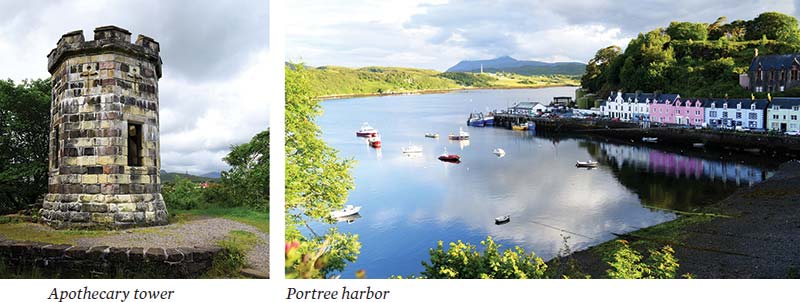
Back on Bank Street, continue uphill. Soon you’ll approach the Portree Medical Centre—one of just two hospitals on the entire Isle of Skye. (Is it just me, or do those parking spots each come with a graveyard cross?)
Just before the hospital’s parking lot, watch on the left for the uphill lane through the trees. Use this to hike on up to the top of the hill that locals call “The Lump” (or, for those with more local pride, “Fancy Hill”). Emerging into the clearing, you’ll reach a huge, flat bowl that was blasted out of solid rock to hold 5,000 people during Skye’s annual Highland Gathering. In addition to the typical Highland dancing, footraces, and feats of strength, Skye’s games have a unique event: From this spot, runners climb downhill, swim across Loch Portree, ascend the hill on the adjacent peninsula, then swim back again.
Walk left, toward the harbor, then head left again onto a path leading away from the bowl; you’ll run into a crenellated apothecary tower. It was built in 1834, not as a castle fortification but to alert approaching sailors that a pharmacist was open for business in Portree. It’s usually open if you’d like to climb to the top for views over the harbor and the region—on a clear day, you can see all the way to the Old Man of Storr.
The Portree TI can offer advice about hikes in the area; if either of the below options interests you, get details there before you head out.
One popular choice, which doesn’t require a car, is called the Scorrybreac Path. To get to the trailhead—three-quarters of a mile from Somerled Square—walk north out of Portree on Mill Road, veer right onto Scorrybreac Road when you’re just leaving town (following the sign for Budhmor), then follow the coastline to the start of the hiking trail, marked by signs. From here, you’ll walk along the base of a bluff with fine views back on Portree’s colorful harborfront.
Drivers can tackle the more ambitious hike up to the Old Man of Storr: You’ll drive about 15 minutes north of town (following the start of my Trotternish Peninsula Driving Tour) and park at the Old Man of Storr trailhead. Green trail signs lead you through a gate and up along a well-trod gravel path through a felled woodland. Once you’ve reached the top of the first bluff, take the right fork, and continue all the way up to the pinnacle. Plan on about two hours round-trip.
Note that Portree’s eateries tend to close early (21:00 or 22:00), and the popular places can merit reservations any evening in the high season.
$$$$ Scorrybreac is Portree’s best splurge, offering a delightful array of well-presented international dishes that draw from local ingredients and traditions. The cozy, modern, unpretentious dining room with eight tables fills up quickly, so reservations are a must (set multicourse menus only, Tue-Sun 17:30-22:30, closed Mon, 7 Bosville Terrace, tel. 01478/612-069, www.scorrybreac.com).
$$ The Isles Inn is a happening place, popular with hikers, with two halves serving the same menu—a brighter high-energy dining area and the darker pub—or you can sit at the bar. Offering a fun energy and warm service, they dish up simple, honest food one notch above pub grub. They have popular burgers, and their big slabs of salmon or haddock are served with fresh vegetables (daily 12:00-15:00 & 17:00-21:30, no reservations possible after 19:00, tel. 01478/612-129, facing the main square, Somerled Square). In summer, the Isles Inn hosts live music several nights a week from 21:30.
$$ Café Arriba is a fun and welcoming space offering refreshingly eclectic flavors in this small Scottish town. With a menu that includes local specialties, burgers, and Italian, this youthful, colorful, easygoing eatery’s hit-or-miss cuisine is worth trying (lots of vegetarian options, daily 7:00-18:00, Quay Brae, tel. 01478/611-830).
$$ The Café, a few steps off the main square, is a busy, popular hometown diner serving good crank-’em-out food to an appreciative local crowd. It’s family-friendly, with a good selection of burgers and fish-and-chips (daily 9:00-15:30 & 17:30-21:00, Wentworth Street, tel. 01478/612-553). Their homemade ice cream from the stand in front is a nice way to finish your meal.
$$ L’Incontro Pizza is Portree’s favorite place for pizza. A sprawling, family-friendly place, it can merit reservations, too (open 17:00-21:00, closed Mon, The Green, tel. 01478/612-535).
Portree’s little harbor has a scattering of good eateries but none have actual waterfront seating. My hunch: It’s because of the mean seagulls that hang out here.
$$$ Sea Breezes is a popular choice, with plain decor and a seafood-focused menu. At this basic, salty, no-nonsense eatery, you’ll likely need reservations for dinner (daily 12:30-14:00 & 17:30-21:30 in summer, shorter hours off-season, closed Nov-Easter, tel. 01478/612-016, www.seabreezes-skye.co.uk).
Fish-and-Chips: Portree has two chippies: $ The Harbour Fish & Chips Shop is delightfully located on the charming harbor with good fish that’s cheap and in big portions (daily 11:00-21:00, later in summer). The down side: Aggressive sea gulls drive diners up against the wall. It’s funny to watch. For a more relaxing meal, $ The Chippy sells very basic fish-and-chips and burgers, just up the harbor lane (on Bank Street) with peaceful-if-grungy tables and no seagulls.
Takeaway in Town: The Fat Panda Asian restaurant on Bayfield Road is satisfying, the Co-op grocery (daily 8:00-23:00) has a small selection of sandwiches and other prepared foods, and Relish is a deli serving good fresh sandwiches (eat in or to go, end of Wentworth Street).
In Sligachan: The Sligachan Hotel (pronounced SLIG-a-hin) is a grand and rustic old hotel in an extremely scenic setting, nestled in the Cuillin Hills. Its Harta Restaurant offers “casual dining with fine food” and a big bar. Popular with campers and hikers, it’s also family-friendly, with a playground. The Seumas Bar has a Scotsman-pleasing range of whiskies. Choose between the lovely $$$ dining room (nightly 18:30-21:00) and the big, open-feeling $$ pub serving microbrews and mountaineer-pleasing grub (long hours daily, food served until 21:30, pub closed Oct-Feb; on the A-87 between Kyleakin and Portree in Sligachan, tel. 01478/650-204).
Portree is crowded with hikers and tourists in July and August: Book your room well in advance. You may need to check with several places. If you’re late to the game, you might have better luck with a hotel, Airbnb, or one of the B&Bs lacking websites. Spring and fall (March-June and Sept-Oct) are also busy, but a bit more manageable (and cheaper).
If looking last-minute, try the Facebook group “Skye Rooms,” where hotels, B&Bs, and short-term apartments list their availability for the next day. Travelers looking for accommodations can also post their desired dates.
$$$ Rosedale Hotel fills three former fishermen’s houses with mazelike hallways and 23 rooms (some modern, some more traditional). With-it Neil runs the hotel with the help of his family including his mom, who cooks (family room and a few small, no-view, cheaper doubles available; no elevator, restaurant, bar for guests only, parking lot down the road; Beaumont Crescent, tel. 01478/613-131, www.rosedalehotelskye.co.uk, reservations@rosedalehotelskye.co.uk).
$$ At Pink Guest House, energetic Robbie and Fiona rent 11 bright, spacious rooms (8 with sea views) on the harbor. The rates include a full Scottish breakfast and the hosts’ youthful enthusiasm (large family rooms, Quay Street, tel. 01478/612-263, www.pinkguesthouse.co.uk, info@pinkguesthouse.co.uk).
$ Marine House, a cozy, welcoming, delightful time warp run by sweet Skye native Fiona Stephenson, has three simple, homey rooms (two with a private bathroom down the hall) and fabulous views of the harbor (cash only, reserved parking right on harbor, 2 Beaumont Crescent, tel. 01478/611-557, stephensonfiona@yahoo.com).
$$$$ The Portree Hotel is your basic, impersonal town-center accommodation (right on the main square) with 24 modernized rooms on three floors and no elevator (family rooms, bar/restaurant, no parking—must use public lots, tel. 01478/612-511, www.theportreehotel.com, contact@theportreehotel.com).
$$ Ben Tianavaig, on the busy road through town overlooking the harbor, offers four fresh and airy rooms (all with views). Charlotte and Bill are generous with travel tips, offer a breakfast special of the day, and foster a shoes-off tidiness (2-night minimum required, cash only, street parking out front; 5 Bosville Terrace, tel. 01478/612-152, www.ben-tianavaig.co.uk, info@ben-tianavaig.co.uk).
¢ Portree Youth Hostel, run by Hostelling Scotland (SYHA), is a modern-feeling, institutional, cinderblock-and-metal building with 54 beds in 16 rooms (private and family rooms available, continental breakfast extra, kitchen, laundry, tel. 01478/612-231, www.syha.org.uk, portree@syha.org.uk).
¢ Portree Independent Hostel, in the unmissable yellow building just off the main square, has 60 beds and equally bold colors inside (one double room and several 4-person rooms, no breakfast, kitchen, laundry, tel. 01478/613-737, www.hostelskye.co.uk, skyehostel@yahoo.co.uk).
Viewfield Road, stretching south from Portree toward the Aros Centre, is B&B central. All offer convenient parking and are within walking distance of town (figure 10-15 minutes). All are well marked from the main road.
$$ Duirinish Guest House feels homey, modern, and tidy. With four rooms, it sits across the main road from the water (only a few obstructed sea views) but comes with a spacious guest lounge and a warm welcome (2-night minimum, closed Nov-March, tel. 01478/613-728, www.duirinish-bandb-skye.com, ruth.n.prior@hotmail.co.uk, Ruth and Allan).
$$ Fishers Rock, a serene waterfront retreat with a glassy, contemporary, light-filled view breakfast room, has a soothing energy and three rooms (2-night minimum, closed in winter, tel. 01478/612-122, www.fishersrock.com, fishersrock@btinternet.com, Heather).
$$ Greenacres Guest House feels estate-like and a bit more formal, with fine china on the table, manicured hedges in the garden, and a sunroom with views. The five rooms have different color schemes and styles (cash only, closed Oct-Easter, one of the farthest houses from town on Viewfield Road, about a 20-minute walk, tel. 01478/612-605, www.greenacres-skye.co.uk, greenacreskye@aol.com, Marie and Ewen).
$ Seaforth Cottage feels like a retired sea captain’s home. Overlooking tidal flats, its garden is artfully littered with nautical flotsam and jetsam. The three simple rooms come with sea views and are a bit older, but priced accordingly (cash only, tel. 01478/612-040, ianskye48@hotmail.co.uk, gentle Ian).
$ Easdale B&B is another old-school place with three rooms, a bright breakfast room, and a large, traditional lounge set just above the busy main road (cash only, no kids, Bridge Road, tel. 01478/613-244—call to reserve; spunky, plainspoken, and happily computer-free Chrissie).
$$ Ballintoy Bed and Breakfast, set back from the road and surrounded by a large field, has three immaculate ground-floor rooms accessorized with fun pops of color and artwork (family room, 2-night minimum preferred, includes continental breakfast, 15-minute walk from town on Staffin Road, tel. 01478/611-719, www.ballintoy-skye.co.uk, ballintoyskye@gmail.com, Gillian and Gavin).
$$$ Sligachan Hotel, perched at a crossroads in the scenic middle of nowhere (yet handy for road-tripping sightseers) is a local institution and a haven for hikers. The hotel’s 21 rooms are comfortable, if a bit dated and simple for the price, while the nearby campground and bunkhouse offer a budget alternative (closed Nov-Feb, on the A-87 between Kyleakin and Portree in Sligachan, hotel and campground tel. 01478/650-204, bunkhouse tel. 01478/650-458, www.sligachan.co.uk, reservations@sligachan.co.uk).
Trotternish Peninsula Loop Drive
CLAN DONALD CENTRE AND ARMADALE CASTLE
On the Mainland, Near the Isle of Skye
It’s most fun to tour Skye by car, stopping wherever you want. (Portree’s car-rental agencies are listed in “Helpful Hints,” earlier.)
Without a car, travelers can choose among day-long minibus tours, which are more time-efficient than relying on public buses. (For more on both, see “Getting Around the Isle of Skye,” at the end of this chapter.)
I’ve organized the sights geographically, roughly from north (near Portree) to south.
This well-trodden tourist path around Skye is clearly the most memorable way for drivers to spend the day. The three big sights are Dunvegan Castle, Talisker Distillery, and Trotternish Peninsula, with its memorable Skye Museum of Island Life. It’s possible—but rushed—to see all three in one day. (The challenge: The Skye Museum of Island Life closes at 17:00.)
To see all three, start with the first distillery tour at 9:30, tour the castle, and get to the museum by about 16:30. This will rush the wonderful natural sights along the peninsula, but it might be worth it if time is short and you want to experience it all.
While you could drive directly from the castle to the museum and then tour the peninsula in a clockwise direction, it’s far more scenic to drive it in a counterclockwise route as proposed here. Summer days are long, and the light can be wonderful in the early evening for the scenic west coast of the Trotternish Peninsula. Another option is to skip the distillery, do the castle first, and then have a leisurely tour of the peninsula as laid out in this chapter. Of course, if you have two days, do it all at your own pace.
This inviting peninsula north of Portree is packed with windswept castaway views, unique geological formations, and some of Scotland’s most dramatic scenery. The following loop tour starts and ends in Portree, circling the peninsula counterclockwise. In good weather, a spin around Trotternish is the best activity Skye offers and is worth ▲▲▲.
With minimal stops, the drive will take about two hours—but it deserves the better part of a day. Note that during several stretches, you’ll be driving on a paved single-track road; use the occasional “passing places” to pull over and allow faster cars to go by.
 Self-Guided Drive
Self-Guided Drive• Head north of Portree on the A-855, following signs for Staffin. About three miles out of town, you’ll begin to enjoy some impressive views of the Trotternish Ridge. You’ll be passing peat bogs and may notice stretches where peat has been cut from the fields by the roadside. As you pass the small loch on your right, straight ahead is the distinctive rock tower called the...
This 160-foot-tall tapered slab of basalt stands proudly apart from the rest of the Storr (as the mountain is called). The unusual landscape of the Trotternish Peninsula is due to massive landslides. This block slid down the cliff about 6,500 years ago and landed on its end, where it has slowly been whittled by weather into a pinnacle.
If you’d like to tackle the two-hour hike to the Old Man, start at the parking lot directly below the formation (for details on the hike, see here).
• After passing the Old Man, enjoy the scenery on your right, overlooking nearby islands and the mainland.
As you drive, you’ll notice that Skye seems to have more sheep than people. During the Highland Clearances of the early 19th century, many human residents were forced to move off the island to make room for more livestock. The people who remain are some of the most ardently Gaelic Scots in Scotland. While only about one percent of all Scottish people speak Gaelic (pronounced “gallic”), one-third of Skye residents are fluent. A generation ago, it was illegal to teach Gaelic in schools; today, Skye offers its residents the opportunity to enroll in Gaelic-only education, from primary school to college (Sabhal Mòr Ostaig, on Skye’s Sleat Peninsula, is the world’s only college with courses taught entirely in Scottish Gaelic.
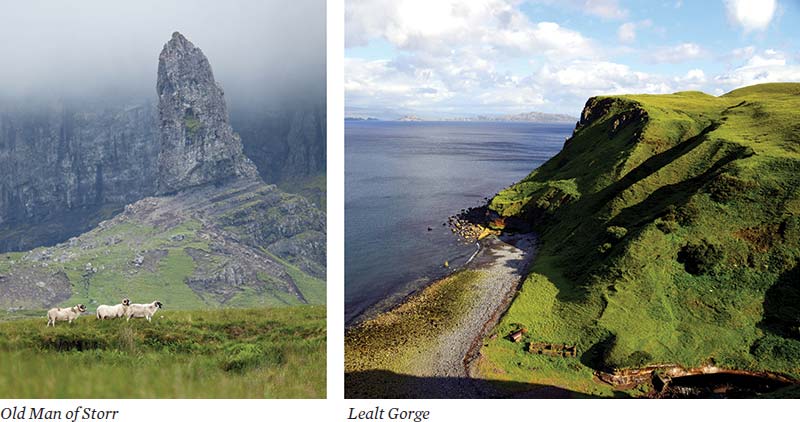
• About four miles after the Old Man parking lot, you’ll pass a sign for the River Lealt. Immediately after, the turnoff on the right is an optional stop at the...
Where the River Lealt tumbles toward the sea, it carves out a long and scenic gorge. To stretch your legs, you can walk about five minutes along the lip of the gorge to reach a viewpoint overlooking a protected, pebbly cove and some striking rock formations. The formations on the left, which look like stacked rocks, are the opposite: They’ve been weathered by centuries of battering storms, which have peeled back any vegetation and ground the stones to their smooth state.
• Continue along the road. Just after the village of Valtos (about 2 miles after the Lealt Gorge viewpoint), you’ll reach a loch (left), next to a parking lot (right). Park at the well-marked Kilt Rock viewpoint to check out...
So named because of its resemblance to a Scotsman’s tartan, this 200-foot-tall sea cliff has a layer of volcanic rock with vertical lava columns that look like pleats (known as columnar jointing), sitting atop a layer of horizontal sedimentary rock. The formations in the opposite direction are just as amazing.
• Continuing north, as you approach the village of Staffin, you’ll begin to see interesting rock formations—basalt rock pillars—high on the hill to your left.
If you need a public WC, partway through town, watch on the left for the Staffin Community Hall (marked Talla Stafainn, sharing a building with a grocer). Or for a coffee or lunch break, you could visit (on the right) the Columba 1400 Centre, a Christian-run retreat for struggling teens from big cities. They run a nice cafeteria and shop to support their work (Mon-Sat 10:00-20:00, closed Sun, tel. 01478/611-400).
• Just after you leave Staffin, watch for signs on the left to turn off and head up to the quintessential Isle of Skye viewpoint—a rock formation called...
You’ll get fine views of this jagged northern end of the Trotternish Ridge as you drive up. Landslides caused the dramatic scenery in this area, and each rock formation has a name, such as “The Needle” or “The Prison.”
At the summit of this road, you’ll reach a parking area.
Rick’s Tip: From the parking lot at the Quiraing, even a short walk to a nearby bluff—to get away from the cars and alone with the wind and the island wonder—is rewarding.
There are several exciting hikes from here for a closer look at the formations. If you’ve got the time, energy, and weather for an unforgettable hike, here’s your chance. You can follow the trail toward the bluff and at the fork decide to stay level (to the base of the formations) or veer off to the left and switch back up (to the top of the plateau). Both paths are faintly visible from the parking area—if it’s busy, you’ll see hikers on each. Once up top, your reward is a view of the secluded green plateau called “The Table,” another landslide block, which isn’t visible from the road.
• You could continue on this road all the way to Uig, at the other end of the peninsula. But it’s more interesting to backtrack, then turn left onto the main road (A-855, now single-track), to see the...
A few miles north, after the village of Flodigarry, you’ll pass the Flodigarry Hotel. Soon after, at the top of a ridge ahead, you’ll see the remains of an old fort from World War II, when the Atlantic was monitored for U-boats from this position.
Farther down the road, at the tip of the peninsula, you’ll pass (on the right) the crumbling remains of another fort, this one much older: Duntulm Castle (free, roadside parking, 5-minute walk from road), which was the first stronghold on Skye of the influential MacDonald clan. It was from here that the MacDonalds fought many fierce battles against Clan MacLeod. The castle was abandoned around 1730 for Armadale Castle on the southern end of Skye. While the castle ruins are fenced off, travelers venture in at their own risk. In the distance beyond, you can see the Outer Hebrides—the most rugged, remote, and Gaelic part of Scotland.
• A mile after the castle, watch for the turnoff on the left to the excellent...
This fine little stand of seven thatched stone huts, organized into a family-run museum, explains how a typical Skye family lived a century and a half ago.
Cost and Hours: £2.50, Easter-Sept Mon-Sat 9:30-17:00, closed Sun and Oct-Easter, tel. 01470/552-206, www.skyemuseum.co.uk, run by Margaret, Hector, and Dinah. Though there are ample posted explanations, the £1 guidebook is worth buying.
Visiting the Museum: The three huts closest to the sea are original (more than 200 years old). Most interesting is The Old Croft House, which was the residence of the Graham family until 1957. Inside you’ll find three rooms: kitchen (with peat-burning fire), parents’ “master bedroom,” and a bedroom for the 10 kids. Nearby, The Old Barn displays farm implements, and the Ceilidh House (a gathering place for the entire community) contains dense but very informative displays about crofting (the traditional tenant-farmer lifestyle on Skye), the Gaelic language, and a fascinating wall of classic Skye postcards.
The four other huts, reconstructed here, house exhibits about weaving, the village smithy, and more.
• After touring the museum, head out to the very end of the small road that leads past the parking lot, to a lonesome cemetery. Let yourself in through the gate to reach the tallest Celtic cross at the far end, which is the...
This fine old cemetery, with mossy and evocative old tombs to ponder, features a tall cross dedicated to the local heroine who rescued the beloved Jacobite hero Bonnie Prince Charlie at his darkest hour. (After the original was chipped away by 19th-century souvenir seekers, this more modern replacement was placed here.) After his loss at Culloden, and with a hefty price on his head, Charlie retreated to the Outer Hebrides. But the Hanover dynasty, which controlled the islands, was closing in. Flora MacDonald rescued the prince, disguised him as her Irish maid, Betty Burke, and sailed him to safety on Skye. (Charlie pulled off the ruse thanks to his soft, feminine features—hence the nickname “Bonnie,” which means “beautiful” or “handsome.”)
• Return to the main road and proceed about six miles around the peninsula. Soon after what was once a loch (now a giant depression), you’ll drop down over the town of Uig (“OO-eeg”), the departure point for ferries to the Outer Hebrides and a handy spot for services (cafés, a gas station, pottery shop, brewery, and WC).
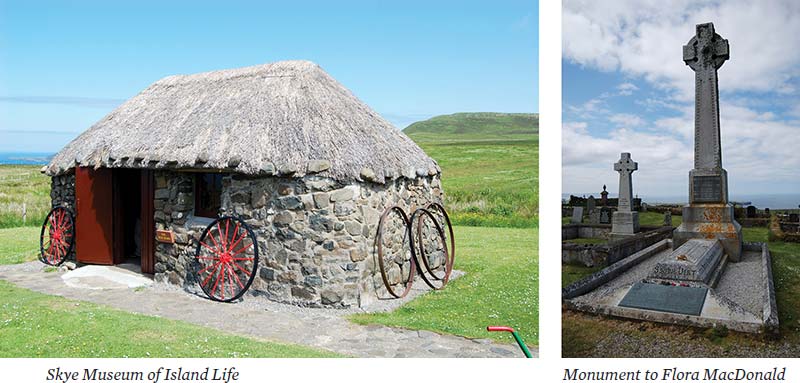
Continue past Uig, climbing the hill across the bay. To take a brief detour to enjoy some hidden scenery, consider a visit to the Fairy Glen. To find it, just after passing the big Uig Hotel, take a very hard left, marked for Sheadar and Balnaknock. Follow this single-track road about a mile through the countryside. You’ll emerge into an otherworldly little valley. Wind through the valley to just past the tiny lake and park below the towering Fairy Castle rock.
Whether or not you believe in fairies, it’s easy to imagine why locals claim that they live here. With evocatively undulating terrain—ruffled, conical hills called “fairy towers” reflected in glassy ponds, rising up from an otherwise flat and dull countryside—it’s a magical place. There’s little to see on a quick drive-by, but hikers enjoy exploring these hills, discovering little caves, weathered stone fences, and delightful views. Hardy hikers enjoy clambering 10 minutes up to the top of the tallest rock tower, the “Fairy Castle.” (By the way, the sheep are actually fairies until a human enters the valley.)
Rick’s Tip: As you explore the Fairy Glen, keep an eye out for “Skye landmines” (sheep droppings).
• Head back the way you came and continue uphill on the main road (A-87), with views down over Uig’s port. Looking back at Uig, you can see a good example of Skye’s traditional farming system—crofting.
Traditionally, arable land on the island was divided into plots. If you look across to the hills above Uig, you can see strips of demarcated land running up from the water—these are crofts. Crofts were generally owned by landlords (mostly English aristocrats or Scottish clan chiefs, and later the Scottish government) and rented to tenant farmers. The crofters lived and worked under very difficult conditions and were lucky if they could produce enough potatoes and livestock to feed their families. Historically, rights to farm the croft were passed down from father to eldest son over generations, but always under the auspices of a wealthy landlord.
• This tour is finished. From here, you can continue along the main road south toward Portree (and possibly continue from there to the Cuillin Hills). Or you can take the shortcut road just after Kensaleyre (B-8036) and head west on the A-850 to Dunvegan and its castle. All of your Skye options are described in the following pages.
Perched on a rock overlooking a sea loch, Dunvegan Castle is the residence of the MacLeod (pronounced “McCloud”) clan. One of Skye’s preeminent clans, the MacLeods often clashed with their rivals, the MacDonalds. The current clan chief, Hugh Magnus MacLeod, is a film producer who divides his time between London and the castle, where his noble efforts are aimed at preserving Dunvegan for future generations. Worth ▲▲▲ to people named MacLeod, the castle offers an interesting look at Scotland’s antiquated clan system, provides insight into rural Scottish aristocratic lifestyles, and has fine gardens that are a delight to explore. Dunvegan feels rustic and a bit worse-for-wear compared to some of the more famous Scottish castles closer to civilization.
Cost and Hours: £13, daily 10:00-17:30, closed mid-Oct-March, café in parking lot, tel. 01470/521-206, www.dunvegancastle.com.
Getting There: It’s near the small town of Dunvegan in the northwestern part of the island, well signposted from the A-850 (free parking). From Portree, bus #56 takes you right to the castle’s parking lot.
Visiting the Castle: Follow the one-way route through the castle, borrowing laminated descriptions in each room—and don’t hesitate to ask the helpful docents if you have any questions. You’ll start upstairs and then make your way to the ground floor with its unforgettable exhibit on the people of St. Kilda.
Up the main staircase and looping left, you reach the bedroom. On the elegant canopy bed, look for the clan’s seal and motto, carved into the headboard. The words “Hold Fast,” which you’ll see displayed throughout the castle, recall an incident where a MacLeod chieftain saved a man from being gored by a bull by literally taking the bull by the horns and wrestling it to the ground.
Beyond the bedroom, you’ll ogle several more rooms, including the dining room (with portraits of clan chieftains and the MacLeod family) and the library, crammed with rich, leather-bound books.
Then you’re routed back across the top of the stairs to the right wing, with the most interesting rooms. The 14th-century drawing room is the oldest part of the castle—it served as the great hall of the medieval fortress. In the 18th century, a clan chief’s new bride requested that it be modernized, so they added a drop ceiling and painted plaster walls.
Leaving the drawing room, notice the entrance to the dungeon—a holdover from that stout medieval fortress. Squeeze inside the dungeon and peer down into the deep pit. (Hey, is that a MacDonald rotting down there?)
At the end of this wing is the north room, a mini museum of the clan’s most prestigious artifacts. In the display case in the corner, find Rory Mor’s Horn—made from a horn of the subdued bull that gave the clan its motto. Other artifacts include bagpipes and several relics related to Bonnie Prince Charlie (including his vest). In the center glass case, next to a lock of Charlie’s hair, is a portrait of Flora MacDonald and some items that belonged to her.
From here a staircase leads to the ground floor where you’ll find some important exhibits in more utilitarian rooms. A glass case holds the Claymore Sword—one of two surviving swords made of extremely heavy Scottish iron rather than steel. Dating from the late 15th or early 16th century, this unique weapon is the bazooka of swords—designed not for dexterous fencing, but for one big kill-’em-all swing.
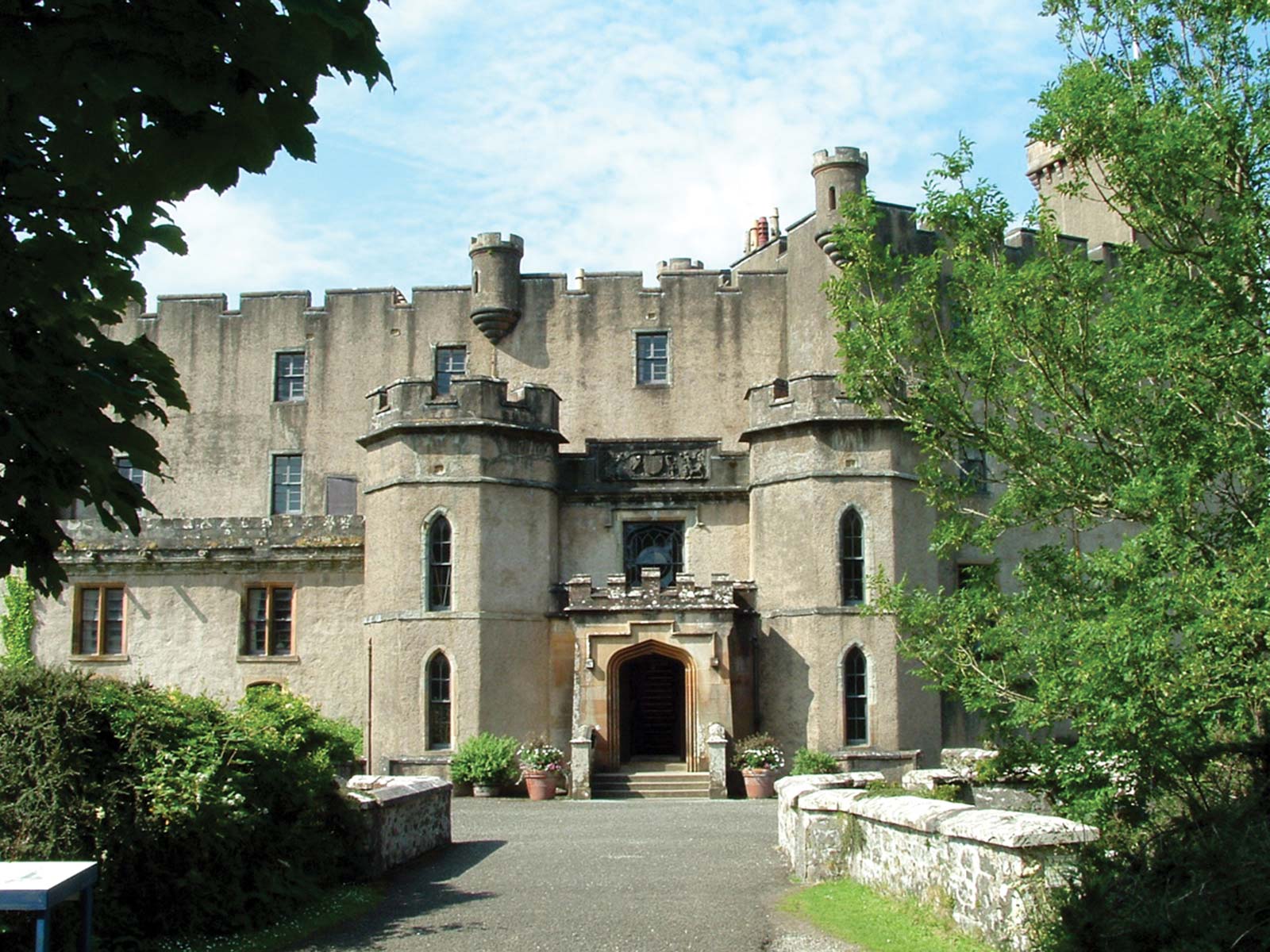
Dunvegan Castle
The MacLeods owned the rugged and remote St. Kilda islands (40 miles into the Atlantic, the most distant bit of the British Isles). They collected rent from the hard-scrabble St. Kilda community of 100 or so (who were finally evacuated in 1930). The artifacts and dramatic photos of this community is a highlight of the castle visit. And, finally, you can watch a 12-minute video about the castle and the MacLeods, solemnly narrated by the 29th chief of the clan.
Between the castle and the parking lot are five acres of plush gardens to stroll through. Circling down to the sea loch, you’ll enjoy grand views back up to the castle (and see a dock selling 30-minute boat rides on Loch Dunvegan to visit a seal colony on a nearby island—£6, tel. 01470/521-500).
Rick’s Tip: Nature lovers head higher up in Dunvegan’s gardens to see its finer, hidden parts: the walled garden, the woodland walk up to the water garden (with a thundering waterfall and a gurgling stream), and the wide-open round garden.
If driving between the distillery and Dunvegan on A-863, you’ll pass Skye’s best-preserved Iron Age fort or “broch.” This 2,000-year-old round stone tower caps a hill a 10-minute walk above its parking lot (just north of the village of Struan). The walk rewards you with an unforgettable chance to be alone in an ancient stone structure with a commanding view.
Talisker, a Skye institution, has been distilling here since 1830 and takes the tours it offers seriously. This venerable whisky distillery is situated at the base of a hill with 14 springs, and at the edge of a sea loch—making it easier to ship ingredients in and whisky out. On summer days, the distillery swarms with visitors: You’ll sniff both peated and unpeated grains; see the big mash tuns, washbacks, and stills; and sample a wee dram at the end. Island whisky tends to be smokier than mainland whisky due to the amount of peat smoke used during malting. Talisker workers describe theirs as “medium smoky,” with peppery, floral, and vanilla notes.
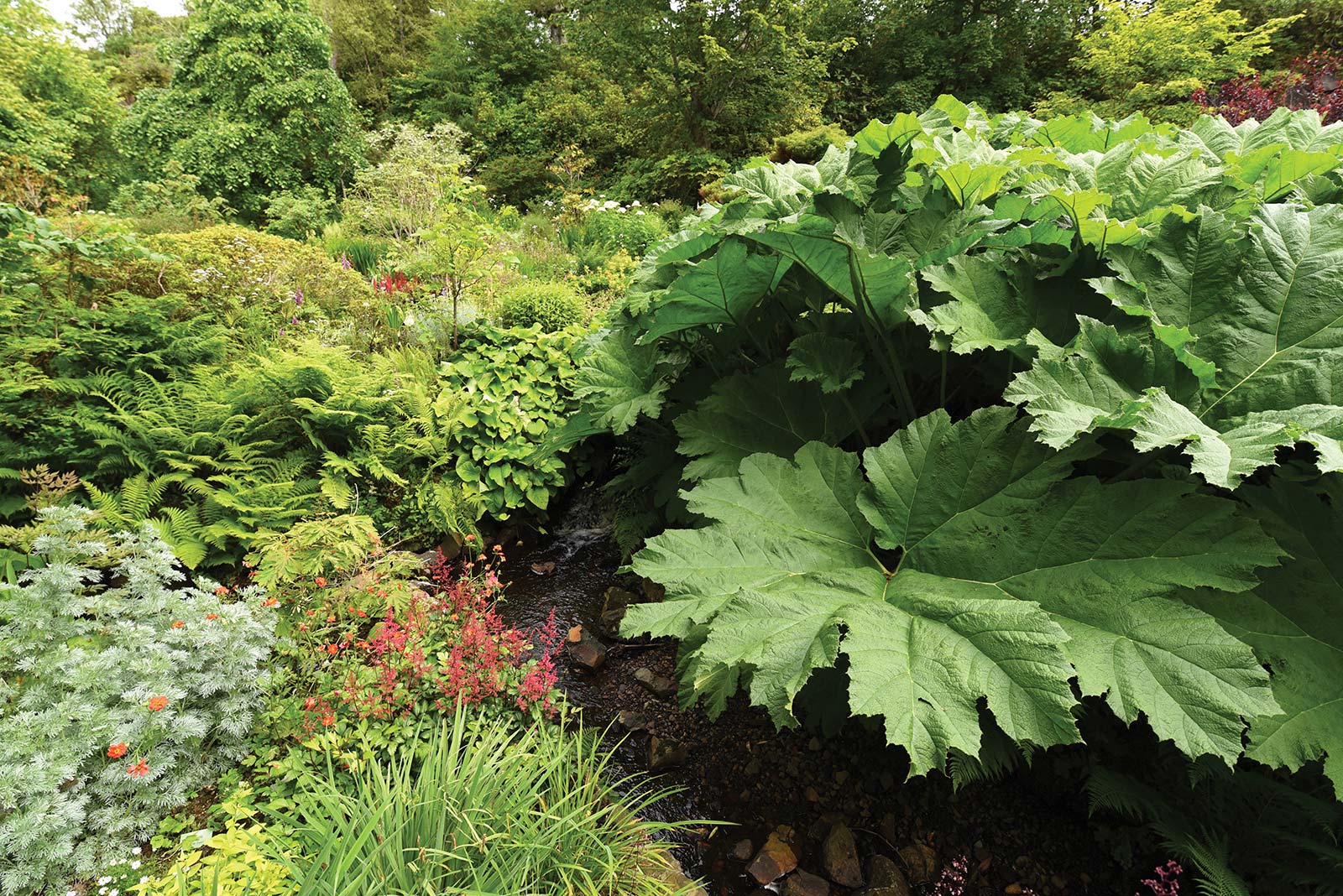
Lush Dunvegan Gardens
Cost and Hours: £10 for one-hour tour with tasting and a £5 voucher toward a bottle; Mon-Fri 9:30-17:00, open Sat-Sun April-Oct only, Sun from 11:00, last tour one hour before closing; 30 tours/day in summer, 4/day in off-season; on the loch in Carbost village, tel. 01478/614-308, www.malts.com. Be sure to call for a reservation (and plan on a 40-minute drive from Portree). Designated drivers who need to skip the tasting can ask for a dram to go.
Nearby: Note that the Fairy Pools Hike—an easy walk that includes some of the best Cuillin views on the island—starts from near Talisker Distillery (see next section).
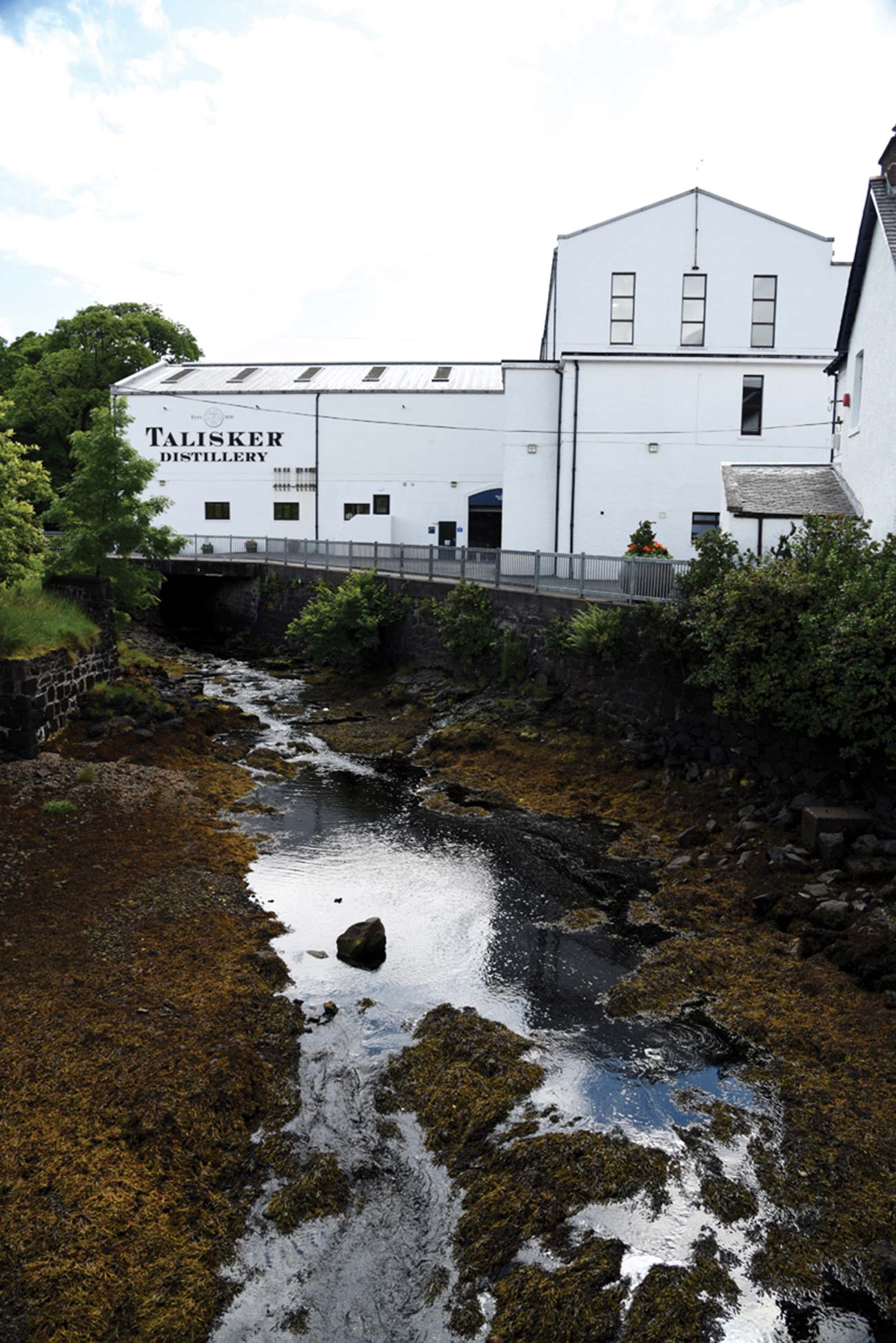
Talisker Distillery
These rocky “hills” (which look more like mountains to me) stretch along the southern coast of the island, dominating Skye’s landscape. Unusually craggy and alpine for Scotland, the Cuillin (“cool-in”) seem to rise directly from the deep. You’ll see them from just about anywhere on the southern two-thirds of the island, but no roads actually take you through the heart of the Cuillin—that’s reserved for hikers and climbers, who love this area. To get the best views with a car, consider these options.
Sligachan: The road from the Skye Bridge to Portree is the easiest way to appreciate the Cuillin (you’ll almost certainly drive along here at some point during your visit). These mountains are all that’s left of a long-vanished volcano. As you approach, you’ll see that there are three separate ranges (from right to left): red, gray, and black. The steep and challenging Black Cuillin is the most popular for serious climbers.
The crossroads of Sligachan has an old triple-arched Telford bridge—one of Skye’s iconic views—and the landmark Sligachan Hotel (listed in “Eating” and “Sleeping,” earlier). The village is nestled at the foothills of the Cuillin, and is a popular launch pad for mountain fun. The 2,500-foot-tall cone-shaped hill looming over Sligachan, named Glamaig (“Greedy Lady”), is the site of an annual 4.5-mile hill race in July: Speed hikers begin at the door of the Sligachan Hotel, race to the summit, run around a bagpiper, and scramble back down to the hotel. The record: 44 minutes (30 minutes up, 13 minutes down, 1 minute dancing a jig up top). A Gurkha from Nepal did it in near record time...barefoot.
Rick’s Tip: You’re welcome to browse around the Sligachan Hotel—a virtual mountaineering museum with great old photos and artifacts throughout its ground floor (especially behind the reception desk).
Fairy Pools Hike: Perhaps the best easy way to get some Cuillin views—and a sturdy but manageable hike—is to follow the popular trail to the Fairy Pools. This is relatively near Talisker Distillery (described earlier).
To reach the hike from the A-863 between Sligachan and Dunvegan, follow signs to Carbost. Just before reaching the village of Carbost, watch for signs and a turn-off on the left to Glenbrittle. Follow this one-track road through the rolling hills, getting closer and closer to the Cuillin peaks. The well-marked Fairy Pools turn-off will be on your right. Parking here, you can easily follow the well-tended trail down across the field and toward the rounded peaks. (While signs suggest a 9.5-mile, 4- to 5-hour loop, most people simply hike 30 minutes to the pools and back; it’s mostly level.)
Very soon you’ll reach a gurgling river, which you’ll follow toward its source in the mountains. Because the path is entirely through open fields, you enjoy scenery the entire time (and you can’t get lost). Soon the river begins to pool at the base of each waterfall, creating a series of picturesque pools. Although footing can be treacherous, many hikers climb down across the rocks to swim and sunbathe. This is a fun place to linger (bring a picnic, if not a swimsuit). As I overheard one visitor say, “Despite the fact that it’s so cold, it’s so invitin’!”
Kyleakin (kih-LAH-kin), the last town in Skye before the Skye Bridge, used to be a big tourist hub...until the bridge connecting it to the mainland enabled easier travel to Portree and other areas deeper in the island. Today this unassuming little village, with a ruined castle (Castle Moil), a cluster of lonesome fishing boats, and a forgotten ferry slip is worth a quick look but little more.
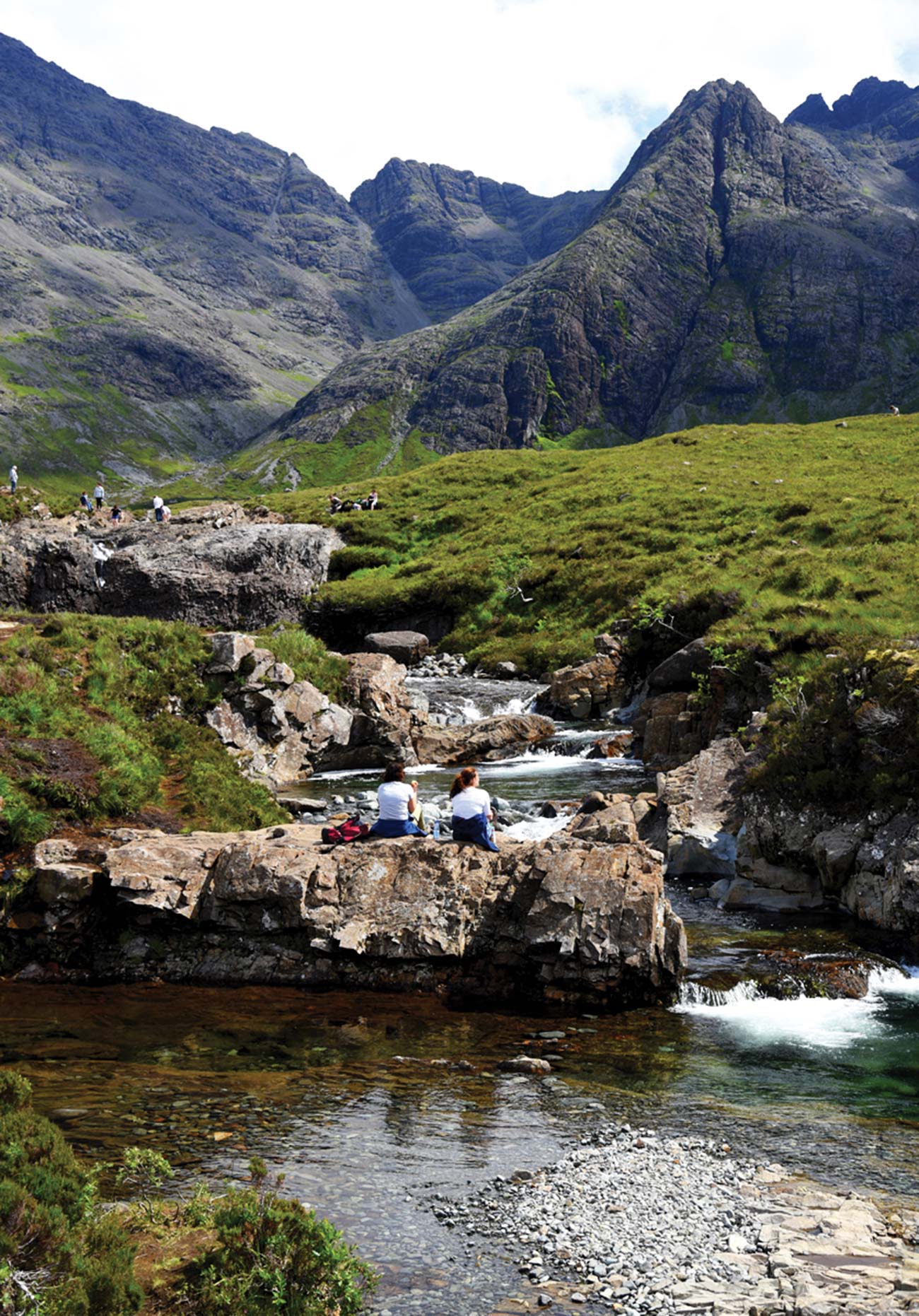
Fairy Pools
Eating in Broadford: Up the road in Broadford is the Broadford Hotel, part of an upscale Skye hotel chain (Torrin Road at junction with Elgol, tel. 01471/822-204, www.broadfordhotel.co.uk). Its $$$$ restaurant is attempting to bring classy cuisine to this small town in a nice contemporary setting with harbor views (set multicourse menu only, daily from 18:00). The hotel’s $$ Gabbro Bar is a relaxed pub grub bistro.
Facing the sea just outside Armadale is the ruined castle of Clan Donald, also known as the MacDonalds (Mac/Mc = “son of”). Today it is the “spiritual home of clan Donald,” a sprawling site with woodland walks, a ruined castle, and a clan history museum.
Armadale Castle—more of a mansion than a fortress—was built in 1790, during the relatively peaceful, post-Jacobite age. Today the ruins (which you can view, but not enter) anchor a visitors center that celebrates the MacDonald way of life. You’ll explore its manicured gardens, ogle the castle ruins, and visit the Museum of the Isles. This modern, well-presented museum tells the history of Scotland and Skye through the lens of its most influential clan (only a few artifacts but good descriptions, includes 1.5-hour audioguide). While fascinating for people named MacDonald, it’s pricey and not worth a long detour for anyone else. But because it’s right along the main road near the Armadale-Mallaig ferry, it can be an enjoyable place to kill some time while waiting for your ferry. At the parking lot is a big shop and café with free WCs.
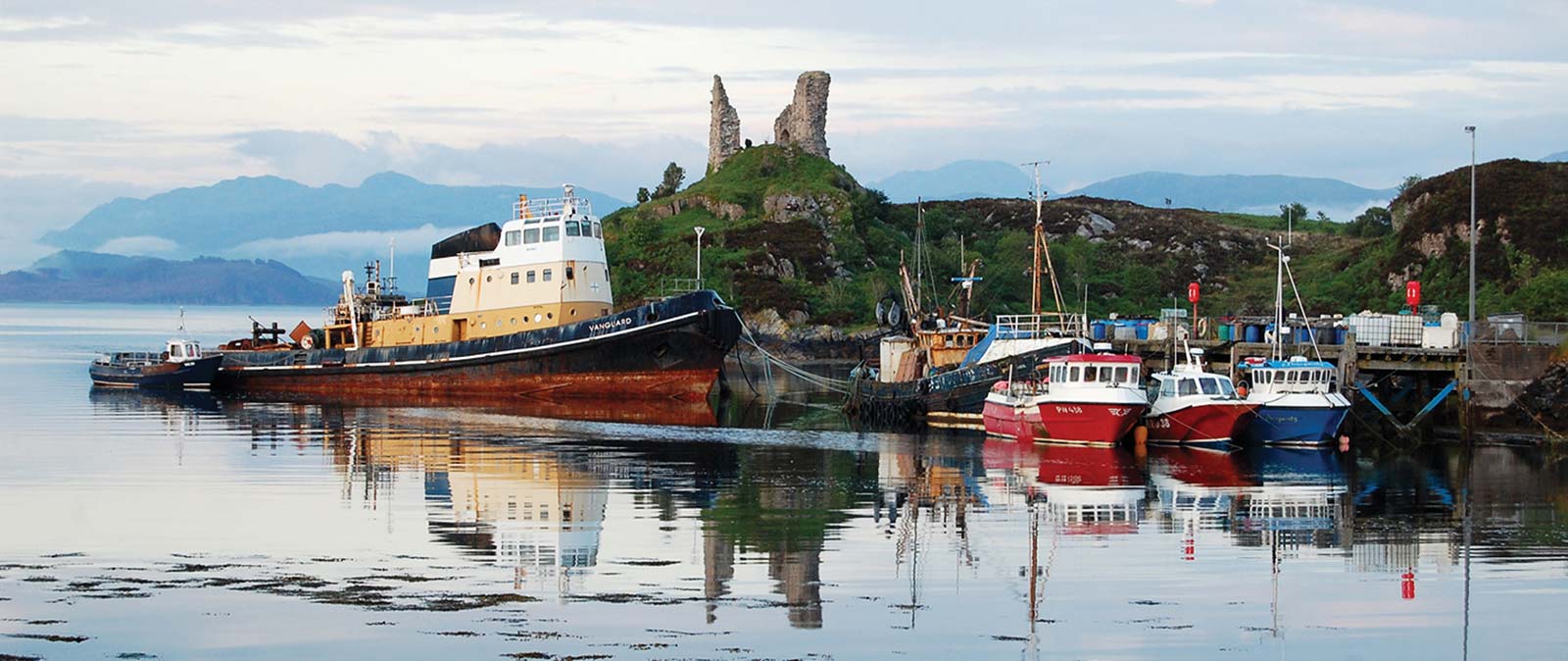
Kyleakin
Cost and Hours: £8.50, Easter-Oct daily 9:30-17:30, closed off-season, 2 minutes north of the Armadale ferry landing, tel. 01471/844-305, www.clandonald.com.
Nearby: Heading north on the A-851 from the Clan Donald Centre, keep an eye out for Sabhal Mòr Ostaig (a big complex of white buildings on the point). Skye is proud to host this college, with coursework taught entirely in Scottish Gaelic. Its mission is to further the Gaelic language (spoken today by about 60,000 people).
This postcard castle, watching over a sea loch from its island perch, is scenically (and conveniently) situated on the road between the Isle of Skye and Loch Ness. While the photo op is worth ▲▲, the interior—with cozy rooms—is worth only a peek and closer to ▲.
Strategically situated at the confluence of three sea lochs, this was the stronghold of the Mackenzies—a powerful clan that was, like the MacLeods at Dunvegan, a serious rival to the mighty MacDonalds. Though it looks ancient, the current castle is actually less than a century old. The original castle on this site (dating from 800 years ago) was destroyed in battle in 1719, then rebuilt between 1912 and 1932 by the Macrae family as their residence.
Cost and Hours: £7.50, good £6 guidebook; March-Oct daily 10:00-18:00, July-Aug from 9:00, may open a few days a week Nov-Feb—call ahead, last entry one hour before closing; café, tel. 01599/555-202, www.eileandonancastle.com.
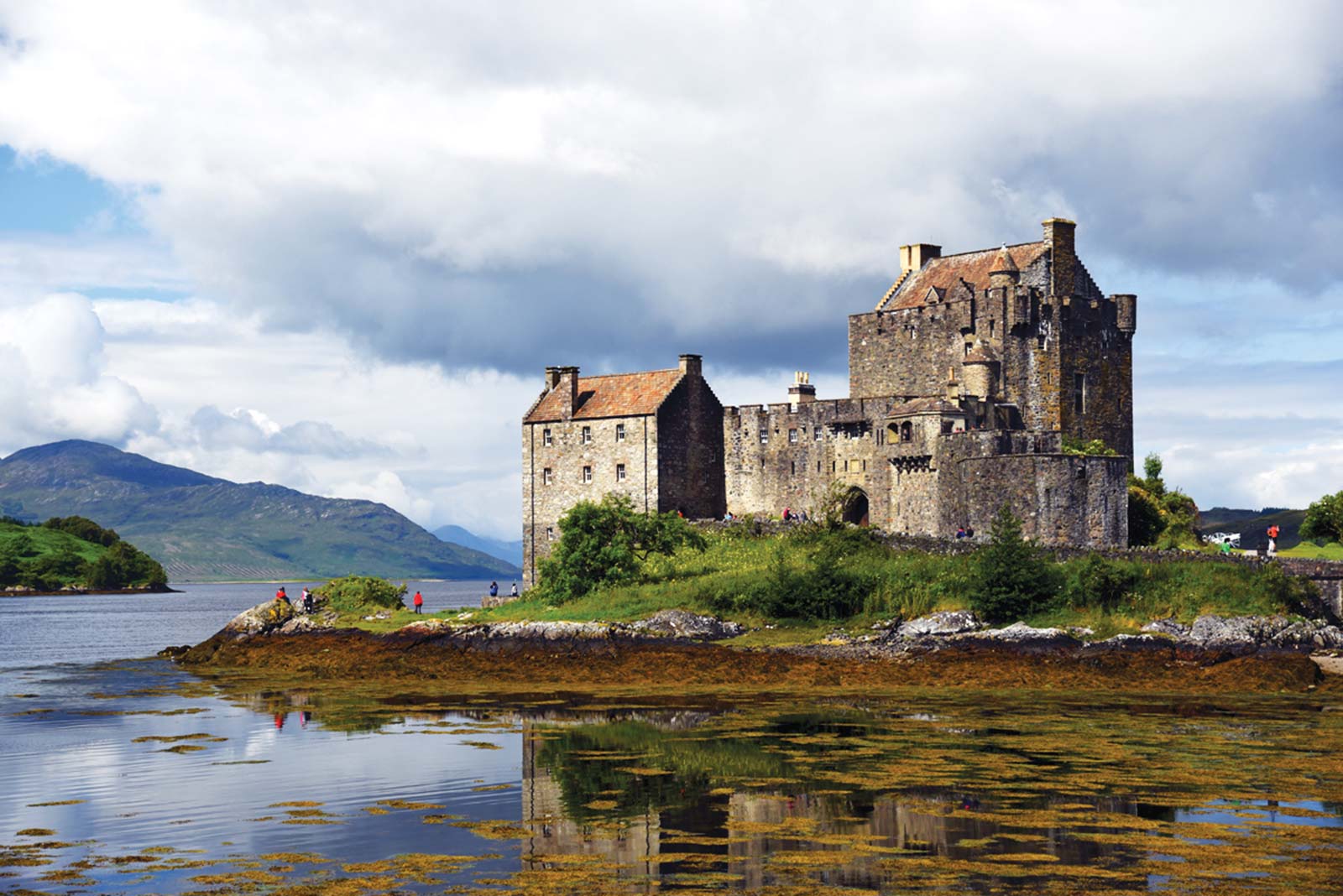
Eilean Donan Castle
Getting There: It’s not actually on the Isle of Skye, but it’s quite close, in the mainland town of Dornie. Follow the A-87 about 15 minutes east of Skye Bridge, through Kyle of Lochalsh and toward Loch Ness and Inverness. The castle is on the right side of the road, just after a long bridge. Buses that run between Portree and Inverness (including #915, #916, and #917) stop at Dornie, a short walk from the castle (6/day, 1 hour from Portree).
Visiting the Castle: Buy tickets at the visitors center, then walk across the bridge and into the castle complex, and make your way into the big, blocky keep. You’ll begin with some audiovisual introductory exhibits (left of main castle entry), then work through the historic rooms. Docents posted throughout can tell you more. First you’ll see the claustrophobic, vaulted Billeting Room (where soldiers had their barracks), then head upstairs to the inviting Banqueting Room, with grand portraits of the honorable John Macrae-Gilstrap and his wife (who spearheaded the modern rebuilding of the castle). This room comes to life when you get a docent to explain the paintings and artifacts here. After the renovation, this was a sort of living room. Another flight of stairs takes you to the circa-1930 bedrooms, which feel more cozy and accessible than those in many other castles—and do a great job of evoking the lifestyles of the aristocrats who built the current version of Eilean Donan as their personal castle playset.
Once on Skye, you’ll need a car to thoroughly enjoy the island. (Even if you’re doing the rest of your trip by public transportation, a car rental is worthwhile here to make maximum use of your time; Portree-based car-rental options are listed in “Helpful Hints,” near the beginning of this chapter.) The roads are simple and well signposted. But if you’ll be exploring, a good map can be helpful. Sample driving times: Kyleakin and Skye Bridge to Portree—45 minutes; Portree to Dunvegan—30 minutes; Portree to the tip of Trotternish Peninsula and back again—2 hours (more with sightseeing stops); Portree to Armadale/ferry to Mallaig—1 hour; Portree to Talisker Distillery—40 minutes.
Skye can be frustrating by bus (slow and limited). Portree is the hub for bus traffic. Most buses within Skye are operated by Stagecoach (www.stagecoachbus.com; buy individual tickets or consider the £8.85 all-day Dayrider ticket; buy tickets onboard). From Portree, you can loop around the Trotternish Peninsula on bus #57A (counterclockwise route) or bus #57C (clockwise route; Mon-Sat 4/day in each direction, limited on Sun). Bus #56 connects Portree and Dunvegan Castle (3/day, does not run on Sun, 40 minutes).From Portree to Kyleakin, take the Inverness-bound Citylink #917 (3/day, 1 hour) or local bus #50 (2/day, 1 hour, none on Sat-Sun); to reach Eilean Donan Castle, take any Citylink bus heading toward Fort William or Inverness (#915, #916, and #917; get off at Dornie and walk, 6/day, 1 hour).
Several operations on the island take visitors to hard-to-reach spots. Figure £40-45 per person to join an all-day island tour (about 8 hours). Compare the offerings at the following companies, which use smaller 8- or 16-seat minibuses: Skye Scenic Tours (tel. 01478/617-006, www.skyescenictours.com), Tour Skye (tel. 01478/613-514, www.tourskye.com), and SkyeBus (tel. 01470/532-428, www.realscottishjourneys.com).
Portree-based Michelle Rhodes also does tours around the island (see Portree’s “Helpful Hints,” earlier).
GoSkye offers a shuttle service to the Fairy Pools, Talisker Distillery, the Old Man of Storr, and the Quiraing (single trips or return, £8-12 one-way, tel. 01470/532-264, www.go-skye.co.uk). Don’s Taxis is available for private rides (tel. 01478/613-100, www.donstaxis.vpweb.co.uk).
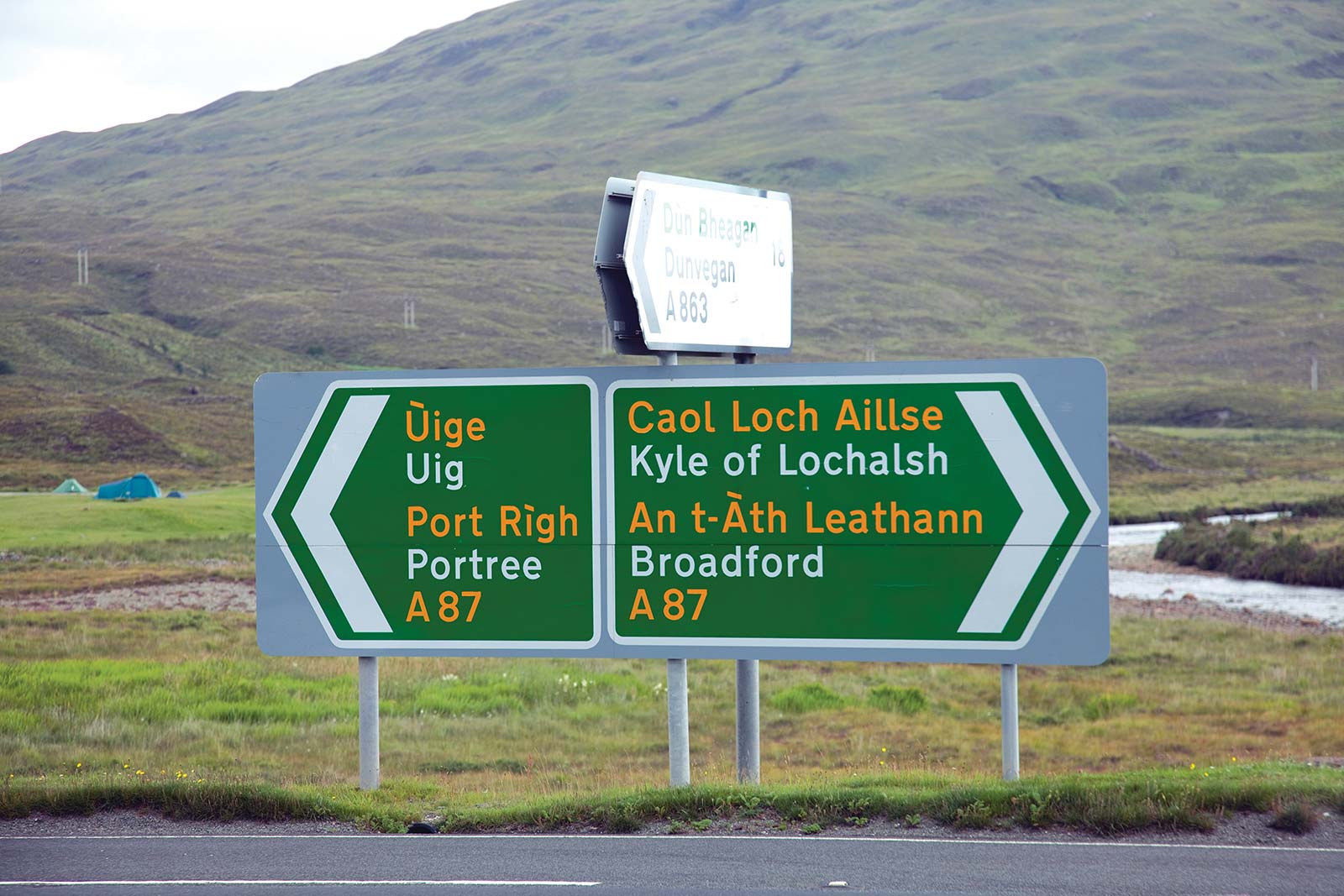
You can’t go wrong.
Situated between Oban/Glencoe and Loch Ness/Inverness, Skye fits neatly into a Highlands itinerary.
Your easiest bet is the slick Skye Bridge that crosses from Kyle of Lochalsh on the mainland to Kyleakin on Skye.
Rick’s Tip: To avoid seeing the same scenery twice, drivers can arrive at the Isle of Skye by ferry (from Mallaig), then take the Skye Bridge out, or vice versa.
The island can also be reached by car ferry. The major ferry line connects the mainland town of Mallaig to Armadale on Skye (£15/car with 2 people, reservations required, April-late Oct 8/day each way, off-season very limited Sat-Sun connections, must check in at least 20 minutes before sailing or your place will be sold and you will not get on, can be canceled in rough weather, 30-minute trip, operated by Caledonian MacBrayne, toll-free tel. 0800-066-5000 or tel. 01475/650-397, can reserve online, www.calmac.co.uk).
For maximum scenery, use both the ferry and the bridge: Drivers coming from Fort William can take the “Road to the Isles” to Mallaig, then catch the ferry to Skye; then later, leave Skye via the Skye Bridge for Inverness, stopping at Eilean Donan Castle en route. (Reverse the route—bridge first, then ferry—if coming from Inverness.)
Skye is connected to the outside world by Scottish Citylink buses (www.citylink.co.uk), which use Portree as their Skye hub. From Portree, buses connect to Inverness (bus #917, 3/day, 3.5 hours) and Glasgow (buses #915 and #916, 3/day, 7 hours, also stops at Fort William and Glencoe). For Edinburgh, you’ll transfer in either Inverness or Glasgow (4/day, 8 hours total).